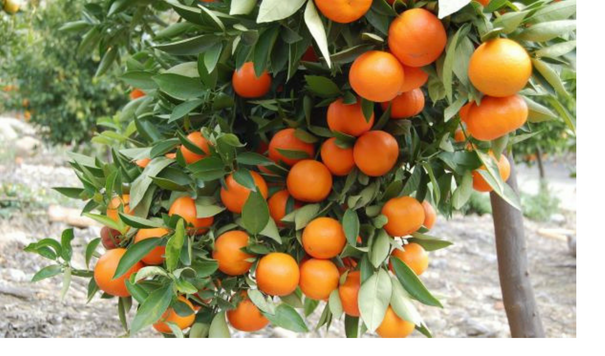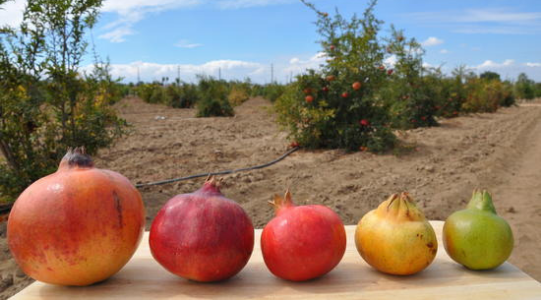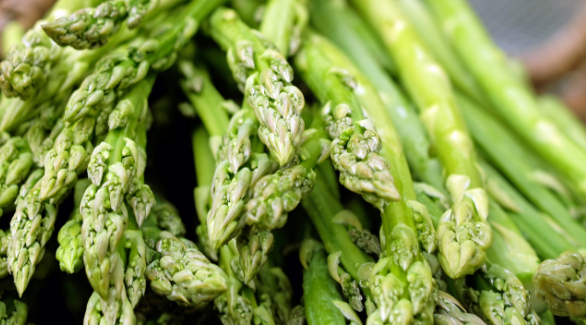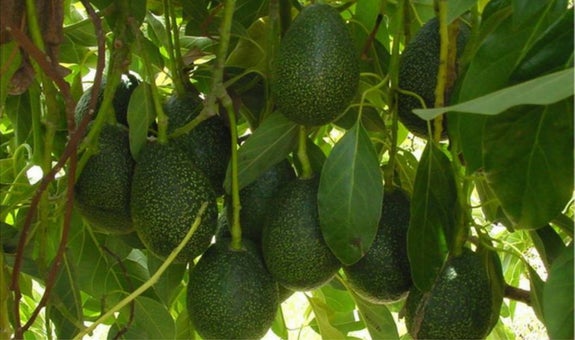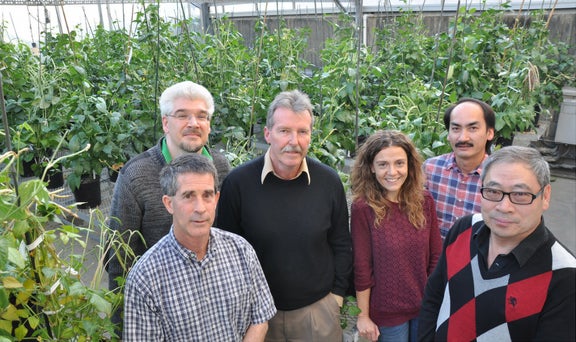Citrus
The Citrus Experiment Station (CES) was established in 1907 after farmers petitioned the state to allocate funding to research on citrus diseases, irrigation problems, nutritional deficiencies, and occasional frosts and pests in order to make the California citrus industry competitive. The CES served as the foundation for UCR, with the campus built up around it. Now renamed the Citrus Research Center and Agricultural Experiment Station (CRC-AES), UCR researchers continue to solve problems facing the industry as well as breeding and patenting new varieties of citrus. One major issue that UCR researchers aim to solve is the spread of Huanglongbing (HLB), also called citrus greening disease, which is currently decimating the citrus industry in several regions around the world. A biosafety-level 3 building is currently being built with funding from industry in order to safely conduct research on HLB. Once built, a $5 million USDA grant will fund research projects aimed at combating HLB including breeding plants for resistance, developing molecular tools to combat disease, new treatment programs with insecticides and bactericides, and early disease detection techniques.
The Citrus Variety Collection (CVC) was established in 1910 to support the developing citrus industry and is now known as a premier germplasm collection worldwide, containing over 1,000 varieties of citrus and citrus relatives. The purpose of the CVC is to conserve and evaluate citrus and citrus relatives, provide a resource of genetic diversity for research, and to provide knowledge about citrus diversity. Citrus researchers at UCR and around the world use the CVC as resource materials. The diverse range of research projects includes scion and rootstock breeding to develop varieties tolerant to desert climates, using molecular techniques to reduce seed set and promote tolerance to pests and diseases, investigation of phylogenetic relationships, and investigation of citrus limonoids as anticancer agents. The citrus scion breeding program has successfully patented seven varieties, available to industry through licensing agreements.
Citrus Research Spotlight
Researchers Move Toward Understanding Deadly Citrus Disease
UCR study will aid the development of new strategies to combat huanglongbing
UC Riverside is Leading the Fight Against Citrus Greening Disease
Experts are available to discuss the spread of huanglongbing and recent research efforts
UC Riverside Gets $5.1 Million to Fight Citrus Killer
Research will focus on attacking huanglongbing, a disease that is destroying Florida’s citrus industry and threatens California
Pomegranate
UCR’s developing pomegranate breeding and research program is spearheaded by Jon Charter, a postdoctoral researcher whose goal is to expand the varieties available to consumers by bringing tastier and hardier varieties to the marketplace. Currently, the Wonderful variety accounts for 90 to 95 percent of all pomegranates grown in the US. When grown in warm climates, Wonderful is rated highly during consumer sensory panel testing, but when grown on the coast, consumers rate the sweetness, tartness, bitterness and seed hardness as less desirable.
To solve the need for varieties that can be grown in cool climates while still satisfying customers, Charter and UCR researchers are growing varieties in both warm and cool climates and using consumer sensory panels to determine which varieties are best suited for either warm inland climates or cool coastal climates. Pomegranates are grown at Riverside when testing for warmer climate and at Ventura for cooler climatic conditions. Both locations are in California, where over 90 percent of pomegranates are grown.
Varieties of interest were chosen from 300 possibilities conserved by the USDA and include Eversweet, Green Globe, Haku Botan, Loffani, Phoenicia and cv. 857 which vary in taste in color, and have varying hues of green, yellow, pink, orange, red, and purple. In addition to researching what climatic conditions varieties grow best under, Charter and UCR researchers are looking for varieties best suited for juicing as well as varieties that ripen earlier which helps prevent fruit loss due to splitting by fall rains, pests and disease.
Pomegranate Research Spotlight
Why An Urban Pomegranate Grove Was Added to Parking Lot 24
The addition of pomegranates to Lot 24 is to make the fruit accessible to the community
Asparagus
The main goal of asparagus research at UCR is to develop asparagus cultivars suited for California’s hot climate that will produce higher yields of green, fresh market asparagus than current cultivars. Cultivars that produce high yields cut labor costs, making them competitive with imports from countries that pay workers lower wages. Researchers are focusing on the development of cultivars with large straight spears and tight heads due to stringent consumer expectations on how asparagus in supermarkets should look. There is an increasing focus on the production of asparagus cultivars that are able to withstand heat spells, which cause susceptible cultivars to grow rapidly until blooming, at which point the crop cannot be harvested. In addition, researchers are identifying cultivars with architecture and regrowth patterns that make them easier to harvest mechanically.
In order to create new cultivars, first parental varieties are selected and then hybrid seeds are produced. These hybrids undergo a field trial to determine which cultivars contain beneficial traits and those selected undergo advanced trials until enough data is obtained to support the release of a new cultivar. However, since asparagus is generally fully productive after 3-4 years and multiple trials must be conducted to determine averages and assess disease susceptibility, it takes several years from the date of the first field trail to commercialization. DePaoli, a culitvar offering high yield and excellent spear quality, first underwent field trials in 1990 but was not commercialized until 2005. The most recent cultivar released by UCR researchers, Espada, produces more on average than DePaoli and has tighter spear heads and a larger spear size. Future efforts are focusing on creating ‘supermales’ that produce male progeny with higher yields and clonal varieties.
Asparagus Research Spotlight
UCR Researchers Release New Variety of Asparagus
UC Riverside Researchers have released a new variety of asparagus that offers a higher yield than previous varieties of the vegetable.
Asparagus Hybrid Named "DePaoli"
Avocado
UC Riverside’s nearly seventy-year-old avocado breeding program aims to create new varieties with the capability to be grown in diverse global areas, produce enhanced post-harvest characteristics, and increase yield and diversity. Research on the ‘Hass’ variety at UCR has provided growers with essential information for decades that has aided in the skyrocketing popularity of avocados worldwide. This research has informed the California avocado industry to make decisions on post-harvest care including temperature sensitivity, storage time, and ethylene exposure. In an effort to help alleviate food insecurity worldwide, UCR researchers have traveled to Central and South America and Tanzania, Africa to share their knowledge on production techniques.
In 2017, UCR launched the Avocado Variety Improvement Program (AVIP) in partnership with industry in order to increase consumer demand by delivering high-quality fruit that can be depended on. Although the demand for ‘Hass’ remains high, the creation of new avocado varieties will protect the avocado industry in the event of an epidemic as well as lead to varieties that are better able to withstand drought and high salinity, the two main issues facing growers today. The development of varieties with differing flowering times from 'Hass' could make it possible for California avocados to stay on shelves year-round, reducing the current need for imports during the off-season. Tasting sessions of potential new varieties are held at UCR to evaluate the likelihood of consumer acceptance. In addition to food production, AVIP goals include commercial oil and sugar production, pharmaceutical uses, and training the next generation of avocado geneticists and breeders. UCR will use blockchain technology through DataHarvest Inc. to create an international network that will generate more data and provide transparency.
Avocado Research Spotlight
UC Riverside Charts Course for Future Avocado Varieties
AVIP will advance new varieties of avocados that will meet the diverse global growing area requirements.
Cowpea
One of the main goals of cowpea research at UCR is to develop superior varieties of cowpea so smallholder farmers will be able to feed their families and villages while producing a surplus that will support economic growth and increase food security in nearby villages. These efforts can benefit millions in African countries by improving the nutritional quality of their diet. In addition, collaboration with researchers and plant breeders in African countries provides training opportunities for scientists and encourages a close working relationship between researchers, breeders, and farmers. The UCR cowpea research program has received a total of $13 million dollars, with the majority allocated to West African partners or used towards the goal of food security in West Africa. Collaboration between UCR scientists and African cowpea breeders has led to successful varieties grown in Senegal, Sudan, Burkina Faso and Ghana, including multiple varieties released in the last two years.
Cowpea production in Africa is only performing around twenty percent of its genetic potential, so research that focuses on developing genomic resources for cowpea breeding can lead to varieties released with significantly more yield. Efforts focus on improving nutritional quality and resistance to drought, pests and disease through plant breeding based on physiological and genetic research. Future steps include sequencing the cowpea genome and creating a genetic map that will give more precision when targeting traits to be accentuated or diminished. In 2016, UCR researchers received a $1.6 million NSF grant to be used towards these aims.
Cowpea Research Spotlight
Scientists Receive Grant to Sequence Cowpea Genome
UCR Scientists further their research developing superior cowpea breeding lines.
Grape
Grapevines are susceptible to wounding and death inflicted by multiple pathogens. Researchers studying grapes at UCR focus on identifying problematic pathogens, investigating their effects on their host vines, and elucidating their genetic structure. This information is then passed on to farmers and agriculture industry professionals in order to provide accurate identification and management tools.
Pathogenic fungi cause wood cankers which can lead to the death of the vine and cause damages of $1.5 billion annually to growers. Dr. Philippe Rolshausen and UCR researchers study these pathogens and have developed a company that sells a beeswax-based seal that growers can apply after pruning to minimize the risk of infection.
Other research focuses on Piece’s disease, which is caused by a bacterial pathogen spread through the invasive glassy-winged sharpshooter. Researchers are investigating the importance of vine to vine spread of the sharpshooter and subsequently the disease and whether climate change may alter the distribution of the sharpshooter and facilitate the spread of the disease.

